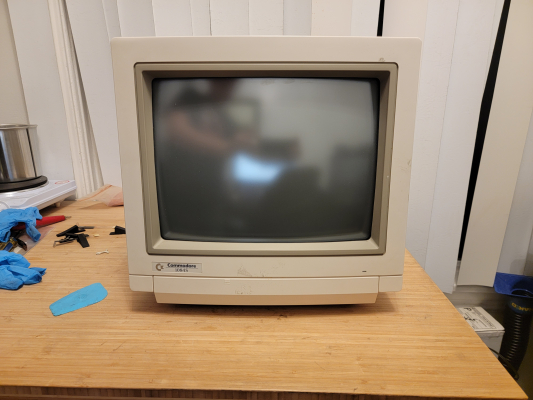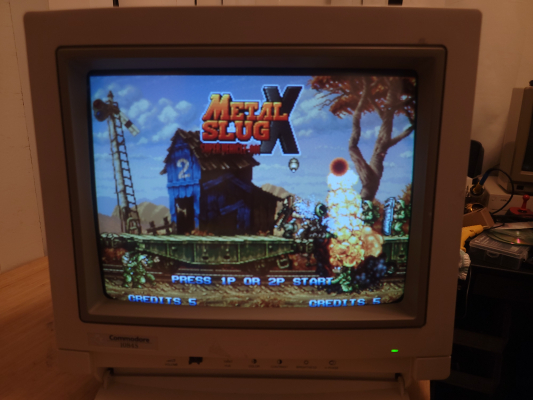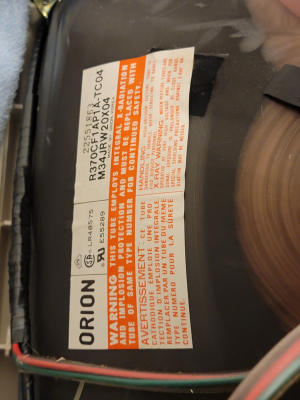Summary
Amigo was a company that added custom capitative touchscreen kits to a variety of different monitors, ranging in size from 13" Commodores to 27" PVM-2530s. More info to come on how the touchscreen part of this system works later.
Manuals
Common Repairs
-
Capacitor replacement: Recommend replacing any "taicon" brand capacitors in these monitors as they have a high failure rate.
-
Broken Power Switch: The power switches in these have latches made of plastic that will eventually break. The easiest solution is to just tape the power switch all the way down and use an external switching power strip to turn the monitor on or off. If you want to repair the power switch you will need a SPDT switch that fits the very specific footprint of the original switch.
Capacitor List
Here is a full list of capacitors courtesy of https://gona.mactar.hu/
Commodore 1084S-D1 and 1084S-D2 Monitor Cap List ------------------------------------------------ Compiled by Guru (http://gurudumps.blogspot.com.au) Updated by Guru 10th March 2019 Notes: 1. Higher voltage caps can be used. 2. DON'T use lower voltage caps or different uF rating! 3. In general if you want your monitor to last replace ALL of the capacitors. 4. Only use quality Japanese capacitors from companies like Rubycon, Nichicon, Nippon Chemicon, Matsushita/Panasonic etc etc. Neck Board: C508 16V 220uF C510 160V 47uF C512 16V 47uF Main Chassis: C109 200V 220uF (for 120V US version). Snap-In type capacitor C109 400V 150uF (for 220V-240V EU/UK/AU version). Snap-In type capacitor C110 50V 22uF C111 50V 1uF C116 160V 100uF C117 160V 100uF C120 35V 470uF C130 50V 22uF C217 50V 1uF C219 50V 4.7uF C220 25V 1000uF C222 160V 10uF C226 50V 10uF C229 16V 10uF (D1 only, empty on D2) C232 16V 220uF C233 16V 47uF C235 50V 3.3uF C236 50V 1uF C237 50V 100uF C239 35V 47uF C241 250V 1uF C306 16V 220uF C307 35V 1000uF C308 35V 100uF C309 35V 470uF C311 63V 47uF C312 50V 10uF C332 16V 10uF (D1 only, empty on D2) C335 50V 1uF C403 16V 470uF C411 50V 10uF C412 50V 4.7uF C413 50V 1uF C414 16V 22uF C415 16V 22uF C417 16V 47uF C421 16V 1000uF C423 50V 2.2uF (D1 only, empty on D2) C605 16V 220uF C620 50V 1uF C621 50V 10uF C703 16V 47uF C707 16V 47uF C708 16V 47uF C709 16V 47uF C801 50V 0.1uF C802 35V 470uF C805 50V 1uF C807 16V 100uF C810 35V 100uF C8011 50V 0.1uF C8021 35V 470uF C8051 50V 1uF C8101 35V 100uF
D2 to D1 conversion
The conversion allows you to add the missing Digital RGBi mode from the D1 model.
Original info from Comos (http://csdb.dk/forums/index.php?roomid=7&topicid=25121)
and Lemon64.com forum post by keropi (http://www.lemon64.com/forum/viewtopic.php?t=52318&postdays=0&postorder=asc&start=12)
Updated 15-09-2017 With clean-ups, corrections and better documentation level by Guru (http://gurudumps.blogspot.com.au)
Modification for Commodore 1084S-D2 monitor to add Digital RGBi mode.
This works with Commodore 128 80 column mode (TTL RGBI) and makes
a 1084S-D2 into a 1084S-D1.
Listed parts are either missing or different on D2.
R242 - remove (in D2 is 330, in D1 is not connected) Resistor quantities
R243 - 330 (in D2 is 2K) -------------------
R245 - 470 (in D2 is wire link) 27 = 1
R246 - 220 (in D2 is 1K5) 100 = 1
R249 - 10K 150 = 3
R250 - 4.7K 180 = 3
R251 - 560 200 = 4
R252 - 560 220 = 1
R253 - 4.7K 240 = 1
R435 - 27 330 = 10
R436 - 2.7K 430 = 6
R437 - 200 470 = 5
R701 - 330 560 = 2
R702 - 330 680 = 1
R703 - 330 820 = 4
R704 - 470 1K = 3
R705 - 470 2.7K = 1
R706 - 470 4.7K = 2
R707 - 330 (in D2 is 10K) 10K = 1
R708 - 470 (in D2 is wire link) 30/5W = 1
R709 - 330
R710 - 330
R711 - 330
R712 - 330
R713 - 330
R714 - 200
R715 - 200
R716 - 200
R717 - 100
R718 - 820
R719 - 680
R720 - 430
R721 - 430
R722 - 430
R723 - 180
R724 - 180
R725 - 180
R729 - 1K
R730 - 1K
R731 - 1K
R735 - 150 (if already present on D2, no change needed)
R736 - 150 (if already present on D2, no change needed)
R737 - 150 (if already present on D2, no change needed)
R738 - 820
R739 - 820
R740 - 820
R741 - 430
R742 - 430
R743 - 430
R744 - 30/5W (in D2 is wire link)
R745 - 240
C701 - 100nF (code=104, polyester or ceramic)
C702 - 100nF (code=104, polyester or ceramic)
C711 - 1.5nF (code=152, polyester or ceramic)
C704 - 10nF - normally no change needed (code=103, polyester or ceramic, if already present on D2, no change needed)
C423 - 2.2uF/50V electrolytic
C229 - 10uF/16V electrolytic
C332 - 10uF/16V electrolytic
J73 - remove 24K resistor and place wire shortcut between the two points
There are a large number of equivalents for transistors.
Use https://alltransistors.com or http://www.semicon-data.com to search for substitutes.
Q203 - 2SC1815
Q401 - 2SC1815
Q701 - 2SC1959 (2SC9013 is compatible but pins 2 & 3 must be swapped)
Q702 - 2SC1959
Q703 - 2SC1959
Q704 - 2SC3337 (2SC2570 can be used as a pin-compatible alternative)
I202 - 74LS86
I403 - LM7805. Remove the wire link between pins 1 & 3 on D2, add 7805 and a heat sink. make heat sink from a piece of metal.
I701 - 74LS06
I702 - 74LS06
add SW1 (4PDT mini push switch latching type. Switch has 2 rows of 6 pins, 12 pins total)
Here's an example.... http://www.altronics.com.au/p/s1520-salecom-4pdt-pcb-mount-mini-pushbutton-switch/
Also get a knob...... http://www.altronics.com.au/p/h6660-5.5mm-black-plastic-knob-for-s-1520/
add L704 bead (same type as L701/L702/L703) or use a link wire
D214 - 1N4148
D216 - 1N4148
D404 - 1N4148
D405 - 1N4148
D704 - 1N4148
D708 - 1N4148
D712 - 1N4148 (in D2 is wire link)
D713 - 1N4148 (in D2 is wire link)
D714 - 1N4148 (in D2 is wire link)
Gallery







 This work is licensed under a
This work is licensed under a